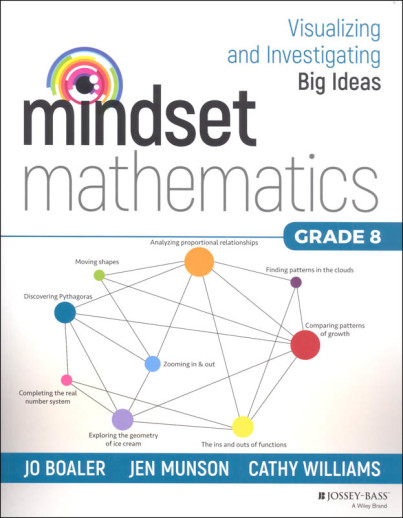We use cookies to make your experience better. To comply with the new e-Privacy directive, we need to ask for your consent to set the cookies. Learn more.
Mindset Mathematics: Visualizing & Investigating Big Ideas Grade 8
Covering topics like congruency, proportional relationships, functions, real numbers, Pythagorean theorem, and geometry, this level of Mindset Mathematics continues with hands-on visual presentations and games to illustrate topics that parallel grade level math courses. Activities are carefully outlined and highlighted with detailed and colorful illustrations. Book includes teacher instructional material along with lesson plans. ~ Janice
The most challenging parts of teaching mathematics are engaging students and helping them understand the connections between mathematics concepts. In this volume, you'll find a collection of low floor, high ceiling tasks that will help you do just that, by looking at the big ideas at the Eighth-grade level through visualization, play, and investigation.
During their work with tens of thousands of teachers, authors Jo Boaler, Jen Munson, and Cathy Williams heard the same message—that they want to incorporate more brain science into their math instruction, but they need guidance in the techniques that work best to get across the concepts they needed to teach. So the authors designed Mindset Mathematics around the principle of active student engagement, with tasks that reflect the latest brain science on learning. Open, creative, and visual math tasks have been shown to improve student test scores, and more importantly change their relationship with mathematics and start believing in their own potential. The tasks in Mindset Mathematics reflect the lessons from brain science that:
- There is no such thing as a math person - anyone can learn mathematics to high levels.
- Mistakes, struggle and challenge are the most important times for brain growth.
- Speed is unimportant in mathematics.
- Mathematics is a visual and beautiful subject, and our brains want to think visually about mathematics.
With engaging questions, open-ended tasks, and four-color visuals that will help kids get excited about mathematics, Mindset Mathematics is organized around nine big ideas which emphasize the connections within the Common Core State Standards (CCSS) and can be used with any current curriculum.
Mindset Mathematics: Visualizing and Investigating Big Ideas. Our brain wants to think visually about math and this program wants to convince us that all of us are "math people". I have never considered myself a math person, so this piqued my interest. If we like what we are good at, and we become good at math, would we then like it? I think we would! The structure of the book involves three steps: visualize, play, investigate. The author goes into the neuroscience research here for several pages. There are some familiar math manipulatives they recommend, and in the kinder level these include: linking cubes, color tiles, dice, pattern blocks, colored pencils/markers/pens, collections of small objects, vessels such as bowls or cups, a digital camera/phone, and some common school supplies such as construction paper, glue sticks, sticky notes, index cards, pipe cleaners, erasers, paper clips and masking tape. When you get to the actual lesson, it is very clearly laid out with time spent on each task and what you will need. You are given questions to ask as you introduce the topic. The parent/teacher is led through the process, which is a confidence builder for those of us who do not fancy ourselves as a math person. There are 8 color-coded categories, which are basically units that contain the lessons. While this is a supplement, it is a hefty one. I found it user friendly and think it would be quite the confidence builder for a child who did not think they were good at math. If I had a time machine, and could start my education over again, I feel like this method would have made me more of a mathematical thinker. ~Sara
| Product Format: | Paperback |
|---|---|
| Brand: | Jossey-Bass |
| Grade: | 8 |
| ISBN: | 9781119358749 |
| Length in Inches: | 10.875 |
| Width in Inches: | 8.5 |
| Height in Inches: | 0.5 |
| Weight in Pounds: | 1.65 |

